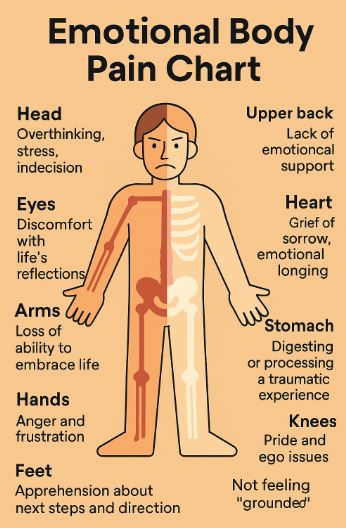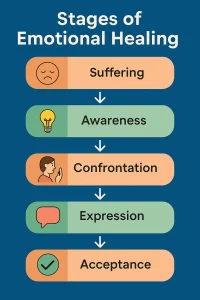 Every toxic trait has a story behind it. A reason. A wound.
Every toxic trait has a story behind it. A reason. A wound.
Sarah is 32. Has it all, successful career, beautiful home, active social life. Everything looked perfect from the outside.
But in a small group discussion, she shared something that stuck. “My life has been built around achievement, never stopping,” she said quietly, head lowered. “Color-coded calendar down to 15-minute blocks. Staying up all night to make presentations ‘just right.’ Trying to manage everyone around me. I’m so tired”
This feeling she described. The hollowness. The breathlessness. The despair so deep you can’t find words.
She didn’t know how to function carrying that much pain. So she found ways to numb it.
Her story wasn’t just another burnout tale. It was realizing that her perfectionism and control issues weren’t character flaws. They were smart responses to emotional neglect in childhood. Love that only came when she achieved.
 “Where Pain Lives in the Body”
“Where Pain Lives in the Body”
This chart shows how unspoken emotional stress often surfaces physically—the body always keeps the score
This is the hidden reality of toxic traits. They’re often born in trauma, big or small.
The Wounds That Create Specific Toxic Traits
Different childhood experiences tend to create different toxic traits. Understanding these connections can show why certain patterns feel so stuck.
Abandonment Wounds
When you experience significant abandonment as a child, you are likely to develop an early warning system for rejection. Whether physical (parent leaving) or emotional (caregiver present but unavailable).
This creates traits like:
- Anxious attachment – Constant need for reassurance that others won’t leave
- People-pleasing – Becoming whoever others want to prevent abandonment
- Relationship sabotage – Leaving before you can be left
- Jealousy and possessiveness – Monitoring for signs someone is pulling away
Marcus’s father left when he was eight. Thirty years later, as an adult, he still interpreted any independence in relationships as the beginning of abandonment. If his partner wanted a night out with friends, he interpreted it like she was already halfway out the door.
So what did he do? He tried to control his relationships. His controlling behavior wasn’t about domination. It was frantic attempts to manage unbearable abandonment anxiety.
Boundary Violation Wounds
When your boundaries weren’t respected as a child, you can develop confusion around appropriate limits. Through physical intrusion, emotional overwhelm, or not being allowed privacy.
This creates traits like:
- Boundary bulldozing – Not recognizing others’ right to say no
- Extreme rigid boundaries – Building walls to protect yourself
- Chronic compliance – Not believing you have the right to set limits
- Passive aggression – Expressing anger sideways because direct boundary-setting feels unsafe
The connection between boundary issues and childhood environments where privacy was seen as secrecy reveals a troubling pattern. Households where secrecy was forbidden or not possible, children never learned the difference between healthy privacy and harmful concealment.
This creates adults who struggle with healthy relationship boundaries. Without a model for healthy separation, people from these backgrounds often move between two dysfunctional extremes: complete emotional fusion or total disconnection.
The lack of privacy modeling in childhood eliminates the possibility of learning balanced intimacy. When secrecy is demonized or not possible, maintaining individual identity within close relationships becomes alien. The result is a binary relationship framework that recognizes only total mesh or total separation.
This pattern explains why many individuals find it nearly impossible to sustain relationships that honor both intimacy and autonomy. They never learned how.
Emotional Invalidation Wounds
When feelings are consistently dismissed, punished, or ignored as a child, confusion around emotional expression develop.
This creates traits like:
- Emotional unavailability – Suppressing feelings until they’re no longer accessible
- Emotional volatility – Feelings emerge as overwhelming floods because they weren’t processed gradually
- Chronic thinking – Using intellect to avoid emotional experiences
- Empathy burnout – Over-tuning to others’ emotions while disconnecting from your own
Imagine childhood homes where feelings were dangerous liabilities. “Don’t cry or you’ll get something to cry about.” “Get over it.” “You’re too sensitive.”
This tends to discourage emotional expression.
Worthiness Wounds
When your sense of being lovable is damaged in childhood, you develop an unhealthy sense of value. This can happen through criticism, comparison, or conditional approval based on achievement.
This creates traits like:
- Perfectionism – Believing you must be flawless to be worthy of love
- Chronic achievement – Trying to “earn” love that should be unconditional
- Impostor syndrome – Never believing accomplishments are legitimate
- Approval addiction – Constant seeking of external validation
Studies back this up. The landmark ACE (Adverse Childhood Experiences) study showed direct connections between childhood trauma and unhealthy behaviors later.
But you don’t need major trauma to develop toxic traits. Sometimes it’s the quieter wounds:
- The parent physically present but emotionally absent or distant
- Subtle messages that you weren’t quite good enough.
- Small rejections that taught you it wasn’t safe to be yourself.
Many try to break toxic patterns without addressing underlying wounds, a receipe for frustration. Force themselves to be vulnerable, only to retreat when it feels threatening. Promise to communicate better, then revert to passive-aggression when feelings are unheard.
Each failure deepens the sense that something is fundamentally wrong.
But the breakthrough comes when you can finally connect these traits to the pain they’re medicating. Learning to ask: “What would happen if this pattern wasn’t there?” is a key question
The answers are revealing. If perfectionism disappeared, feeling unlovable might surface. If control wasn’t possible, disaster might strike. If vulnerability showed, it might be used as a weapon.
Only by acknowledging these core fears can proper healing begin. Instead of fighting perfectionism, address the belief that value is tied to achievement. Instead of forcing relaxation about control, work on developing safety that doesn’t depend on managing everything.
This isn’t easy work, it really isn’t. Looking directly at hidden pain requires courage. But it’s necessary. No amount of willpower can overcome a trait serving a purpose that hasn’t been addressed.
The key isn’t forcing yourself to stop. It’s understanding what made you start.
To understand the emotional roots of toxic behaviors, explore this in-depth article from Psychology Today.
How Relationships Expose Our Toxic Traits
There’s no better mirror for toxic traits than close relationships. These intimate connections trigger our deepest insecurities and most ingrained patterns. Not to punish us, but to show us what needs healing. Relationships actually exist to trigger us, so the old, hidden stuff can come up to be released; bit like stirring up the bed of a shallow stream. The once crystal clear stream becomes muddied and cloudy…only because it was hiding layers of deep sediment
Picture this. You’re cooking dinner with your partner, it’s a beautiful evening. They suggest adding more garlic to the pasta sauce. Instead of considering the idea, you knee jerk and defend your recipe. Reference your culinary training. Mention how your grandmother won awards for her sauce.
Over garlic. In your kitchen. With no judges present.
Your partner looks at you with confusion and hurt. “I wasn’t challenging you. I just like garlic.”
Suddenly you see the pattern that’s been running your life. Turning casual suggestions into threats. Peaceful moments into battlegrounds you have to win.
Close relationships expose toxic traits through three main ways:
Triggering Attachment Wounds
When we bond closely with someone, it activates the same attachment system formed in our earliest relationships. If we experienced inconsistent love as children, even minor disappointments in adult relationships can trigger old fears of abandonment.
This happens all the time. Your partner is late to meet you. On the surface, you’re a tad annoyed. Internally, you’re spiraling into the same feelings of worthlessness you experienced with a chronically absent parent.
Your response – childish cold withdrawal and punishing silence – makes no sense for a 20-minute delay. But makes perfect sense for the 20-year-old wound it’s triggering.
Ever notice how your reactions sometimes are wildly out of proportion to what’s actually happening? That’s often your attachment system getting activated.
Challenging Defense Systems
We all develop mental defenses to protect vulnerable parts. In isolation, these defenses often work well enough. But intimate relationships require lowering these guards, exposing the soft spots we’ve carefully protected.
Jamie had perfected emotional self-sufficiency. Never needing anyone. Handling everything alone. Keeping relationships pleasant but surface-level. He was an island onto herself.
This worked fine until she fell deeply in love with someone who wanted genuine intimacy. Suddenly her defenses felt like obstacles rather than protections. But dismantling them brought utter terror and feelings of being out of control, rather than relief.
It’s hard to explain to someone who hasn’t experienced it. This feeling of wanting closeness so badly while simultaneously feeling like it might destroy you. The way defenses fight to protect you from the very thing you most deeply want.
Creating Interdependence
Many toxic traits operate smoothly and in the shadows when we maintain complete independence. But relationships create natural interdependence. Our actions affect others. Theirs affect us. This connection makes it impossible to ignore the impact of our patterns.
A brother’s perfectionism seemed like a personal virtue until he became a father. Suddenly his impossibly high standards weren’t just making him miserable, they were creating an environment where his children felt they could never measure up.
His eight-year-old daughter hid a drawing when he walked into her room. “It’s not good enough yet,” she explained. The look of recognition in his eyes – seeing his own pattern reflected in his child – was both painful and profound.
The painful reality is that our closest relationships often bear the brunt of toxic traits. The people we love most get our most unhealed parts. Not because we care for them less, but because these relationships access our deepest vulnerabilities.
This is both the tragedy and opportunity of intimate connection. These relationships reveal wounds with sometimes brutal clarity. But in doing so, they offer the precise diagnosis needed for healing, if of course we can stay present as they arise.
The very relationships that expose toxic traits are often the ones that can help transform them. If we’re willing to see the mirror they provide as a gift rather than an attack. This is rare indeed. We get triggered because they got triggered, and so the spiral down starts.
Toxic traits feel normal to us because they’re all we’ve known. To others, they’re confusing at best and harmful at worst.
Let me be completely honest with you here.
The most painful realization is that the people who love us most are the ones who can see our toxic traits most clearly. And sometimes, their feedback feels like an attack because it threatens the very defenses we’ve built to feel safe.
How to Tell If It’s a Toxic Trait or Just Part of Your Personality
This is a question many struggle with. After all, not every character quirk is a toxic trait.
Here are some distinctions that help:
Toxic traits typically cause suffering – either to yourself or others. They damage relationships, limit growth, or continue emotional pain. They often emerge from wounds rather than authentic preferences. Crucially, they operate automatically, outside conscious choice.
For example, being introverted and needing alone time isn’t a toxic trait – it’s genuine temperament. But using withdrawal as punishment during conflict likely is.
Having high standards isn’t toxic. Criticizing yourself or others mercilessly when those standards aren’t met suggests a toxic pattern.
Helpful questions to ask: “Is this expression coming from wholeness or woundedness? Does it expand life or contract it? Does it deepen connections or damage them?”
The answers usually clarify whether something is a toxic trait or authentic personality.
Actually, let me back up – that’s not entirely accurate.
Even behaviors that seem positive – like being the person who always takes care of others – can be toxic traits if they’re coming from a wounded place.
“Helpfulness” that’s really an attempt to make yourself indispensable so people won’t leave you. Understanding that was both devastating and liberating.
Expert Insights on Toxic Traits
Understanding toxic traits requires multiple perspectives.
 Dr. Gabor Maté’s work on trauma and addiction offers valuable insights into how toxic traits develop as adaptations to difficult environments. His book “When the Body Says No” provides profound understanding of how defensive patterns impact physical health.
Dr. Gabor Maté’s work on trauma and addiction offers valuable insights into how toxic traits develop as adaptations to difficult environments. His book “When the Body Says No” provides profound understanding of how defensive patterns impact physical health.
Pete Walker’s research on complex PTSD and defense mechanisms provides clear frameworks for understanding how childhood experiences shape adult behavior patterns. His concept of “emotional flashbacks” helps explain why we sometimes react way out of proportion to minor triggers.
The Internal Family Systems (IFS) model developed by Richard Schwartz offers a compassionate approach to working with parts of ourselves that carry toxic traits. Rather than fighting these aspects, IFS suggests understanding their protective intent while helping them find new, less harmful ways to fulfill their role.
As we move into Part 3, we’ll explore practical tools and strategies for transforming toxic traits into authentic strengths. We’ll look at specific approaches that can help rewire these patterns and create new ways of meeting legitimate needs – without the collateral damage toxic traits can cause.
Remember, awareness is already the beginning of healing. By recognizing these patterns and understanding their origins, you’ve taken the most crucial step on this journey.
I wonder why we’re taught to hide these parts of ourselves? Why do we believe that acknowledging toxic traits makes us worse people when it’s actually the path to becoming better ones?
These questions help reveal the emotional layers behind perfectionism, control, people-pleasing, and other toxic patterns. Use the thermometer to rate how often each pattern shows up in your life.
🧠 Self-Awareness Quiz: Is There Hidden Pain Behind Your Behavior?
Instructions: Rate each statement from 1 (Never) to 5 (Almost Always) based on how often it feels true for you.
| # | Statement | 1 | 2 | 3 | 4 | 5 |
|---|---|---|---|---|---|---|
| 1 | I feel the need to control situations to feel safe. | ☐ | ☐ | ☐ | ☐ | ☐ |
| 2 | I struggle to express what I need emotionally. | ☐ | ☐ | ☐ | ☐ | ☐ |
| 3 | I resent others silently but rarely speak up. | ☐ | ☐ | ☐ | ☐ | ☐ |
| 4 | I find it hard to trust people with my real feelings. | ☐ | ☐ | ☐ | ☐ | ☐ |
| 5 | I worry about being rejected if I show vulnerability. | ☐ | ☐ | ☐ | ☐ | ☐ |
| 6 | I over-function for others but neglect my own needs. | ☐ | ☐ | ☐ | ☐ | ☐ |
| 7 | I fear being seen as weak, so I stay guarded. | ☐ | ☐ | ☐ | ☐ | ☐ |
| 8 | I feel intense shame when I make mistakes. | ☐ | ☐ | ☐ | ☐ | ☐ |
| 9 | I try to appear perfect so others won’t criticize me. | ☐ | ☐ | ☐ | ☐ | ☐ |
| 10 | I get triggered by small things but suppress the reaction. | ☐ | ☐ | ☐ | ☐ | ☐ |
| 11 | I often feel like I’m not good enough, no matter what I do. | ☐ | ☐ | ☐ | ☐ | ☐ |
| 12 | I say yes even when I’m overwhelmed or exhausted. | ☐ | ☐ | ☐ | ☐ | ☐ |
| 13 | I seek approval to feel worthy. | ☐ | ☐ | ☐ | ☐ | ☐ |
| 14 | I avoid conflict by pretending I’m fine. | ☐ | ☐ | ☐ | ☐ | ☐ |
| 15 | I judge myself harshly for having emotional needs. | ☐ | ☐ | ☐ | ☐ | ☐ |
| 16 | I push people away before they can hurt me. | ☐ | ☐ | ☐ | ☐ | ☐ |
| 17 | I minimize my feelings and tell myself to “just get over it.” | ☐ | ☐ | ☐ | ☐ | ☐ |
| 18 | I feel responsible for fixing others’ emotions. | ☐ | ☐ | ☐ | ☐ | ☐ |
| 19 | I feel unsafe when things are uncertain or unstructured. | ☐ | ☐ | ☐ | ☐ | ☐ |
| 20 | I keep busy or distracted to avoid feeling what’s underneath. | ☐ | ☐ | ☐ | ☐ | ☐ |
Scoring: Add up your points (1–5 per question):
- 20–39: Emotionally aware, with healthy patterns.
- 40–69: Some hidden wounds may be shaping behavior. Reflect gently.
- 70–100: Survival patterns may be shielding deeper pain. Consider further support or exploration.
FAQs
Do all toxic traits come from childhood trauma?
Not necessarily. While many toxic traits have roots in early experiences, they can also develop from later traumas, cultural conditioning, or even positive experiences that become imbalanced. However, childhood is when our core attachments and emotional regulation systems form.
Can you have toxic traits even with a “good” childhood?
Yes. Even well-meaning parents can inadvertently contribute to toxic trait development through emotional unavailability, inconsistent responses, or subtle conditional love. Afterall, they themselves will be carrying their own wounds as well. Sometimes what seems like a “good” childhood to outsiders involved emotional neglect or unrealistic expectations that created wounds.
How do I know if my partner’s feedback about my toxic traits is accurate or manipulative?
Look for patterns across multiple relationships and situations. Valid feedback usually comes with specific examples, focuses on behaviors rather than character attacks, and is offered with care rather than contempt. If multiple trusted people have mentioned similar concerns, it’s worth examining.
Recommended
Breaking Free from Toxic Traits: Tools That Work (Part 3)






